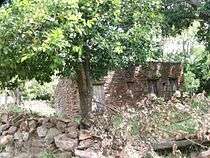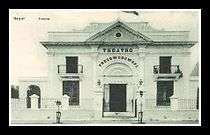Itaqui
| Itaqui | |||
|---|---|---|---|
|
A view of the Uruguay river from the port of Itaqui (Background: Alvear, Corrientes, Argentina) | |||
| |||
| Nickname(s): The Portal of Rio Grande | |||
 Itaqui's location in the state of Rio Grande do Sul | |||
| Coordinates: 29°7′S 56°33′W / 29.117°S 56.550°WCoordinates: 29°7′S 56°33′W / 29.117°S 56.550°W | |||
| Emancipated? | December 6, 1858 | ||
| Government | |||
| • Type | Prefecture | ||
| • Mayor (Prefeito) | Gil Marques Filho | ||
| Area | |||
| • Total | 3,406 km2 (1,315 sq mi) | ||
| Elevation | 57 m (187 ft) | ||
| Population (2004) | |||
| • Total | 41,902 | ||
| Time zone | Brasilia (UTC-3) | ||
| CEP (Post Code) | 97650-000 | ||
| Website | http://www.itaqui.rs.gov.br | ||
Itaqui is a municipality in Brazil, located in the southwestern part of the state of Rio Grande do Sul, close to the Argentinian border, between Uruguaiana and São Borja. It sits at a mean altitude of 57 meters (187 ft), by the Uruguay River. Its population is currently estimated at 42,000.
Geography
The municipality contains part of the 4,392 hectares (10,850 acres) São Donato Biological Reserve, a strictly protected conservation unit created in 1975 that protects an area of wetlands on the Butuí River, a tributary of the Uruguay River.[1]
Politics
The city's first mayor was Felipe Nery de Aguiar, (1896–1900).
History

The city's inhabitant denom. is Itaquiense / Gaúcho. The city’s patron saint is Saint Patrick.
Arts
Theater Prezewodowski History


Theatro Prezewodowski, or Teatro Prezewodowski, was built in 1883 and is one of the oldest in South America. It is constructed of masonry, with a façade 15 meters high—an important characteristic being the mobile auditorium, which, with a special mechanism, puts the main floor level with the stage, for balls and other types of events. The façade above the main entrance is decorated with an entrance porch with two Roman columns. Windows are on either side of this main entrance on the ground and first floor levels, and the first floor has two doors with fences of iron.
The name of the Theater is a hommage to Estanislau Przewodowski, who fought in the Paraguayan War (1864–1870) and was of Polish-descendant, (he was born in Bahia) and then leader of the Flotilla of the High, Uruguay River, unit of the Brazilian Navy, that was anchored here in the waters of the Uruguay River in Itaqui, during approximately 40 years. The Prezewodowski Theater is situated in front of the “Square Marshal Deodoro da Fonseca” and at the side of the Municipal City hall.
During many years the theater had been the scene of stage plays of great international theatrical companies, that played in Brazil, in the axis Porto Alegre-São Paulo-Rio de Janeiro, and then going on to Buenos Aires and Montevideo. Due to the ease of the rivber travel, these European companies always played in Itaqui's Theater, giving to the city the nickname of “Small Paris.” Not only the foreign companies were attractions at the Theater, the biggest names of the Brazilian stage also have played in it, such as Prócopio Ferreira, Maria de La Costa, Nicete Bruno, Wilson Grey, Vicente Celestino and others famous artists from Teatro Municipal (Rio de Janeiro).[2]
With the advent of the Second World War, that prevented the coming of theatrical companies to Brazil, the Theater went into decay.
The city administered the Theater until 1928, when the cinematographic entrepreneur Manoel Barbosa leased it monthly for R$350,000 réis. In 1931, it was leased to another entrepreneur, Mr. Eduardo Corbacho for the equivalent 10% of the incomes of the spectacles, with a minimum guarantee of R$300,000 réis. In 1933 the company Contursi & Cia leased it for the monthly value of R$600,000 réis, with the obligation to make it function at least four times per month, on condition that solo artists or the city’s artists played in it.
In 1942, the building was sold at public auction, as a result of an action moved by a shareholder, who desired to recover the value of capital that she had subscribed. The building was bought in the auction by the city’s medic and politician Dr. Roque Degrazia, who later, for the same price that he had paid, sold it on to the city’s administration, which is still today the owner of its patrimony.
Economy
Port of Itaqui

Itaqui is a major port in South Brazil for bulk cargoes such as manganese and fertilizer. It is a river port and can accommodate ships of upto 11 metres draft (marine) or 100,000 tonnes deadweight tonnage. [3]
Agriculture
Itaqui is the 2nd largest rice producer of the state and CAMIL INC. is the greatest rice Industry of Latin America. It uses the brand name of CAMIL in rice, soya oil and bean that it industrializes. The company was created in Itaqui in the 60s. Now has great business|enterprises in São Paulo, Uruguay and at the city of Camaquã and Maçambara.
Together with Itaqui's branch, JOSAPAR INC., from the city of Pelotas is the producer of ‘TIO JOÃO’ brand name rice and is the 2nd major rice industry of Latin America.
Cattle
The economy of the city is also based on large purebred creations of British and European cattle like Angus, Hereford, Charolais, Simmental and many others contemporary breeds as the result of crossing two or more of the older breeds like Santa Gertrudis purebred, from Texas, United States.
References
- ↑ Inaugurado em São Borja Escritório da Reserva Biológica do São Donato (in Portuguese), Secretaria do Ambiente e Desenvolvimento Sustentável do Rio Grande do Sul, 27 May 2002, retrieved 2016-04-19
- ↑ pt:Teatro Municipal do Rio de Janeiro
- ↑ "Port Information - Itaqui". http://www.magioli.com. MAGIOLI. Retrieved 24 October 2016. External link in
|website=(help)
- The 2002's book "ITAQUI", by Iara Maria Pazetto Rossi.
- The photo "Sundown at Uruguai River seen from the Port of Itaqui/RS" was shot by Belmiro Elói Bittencourt da Rosa on 24-apr-2005 05:40.
External links
| Wikimedia Commons has media related to Itaqui. |
English
- (English) The Jesuit Missions (REDUCCIONES) in South America.
- (English) The Jesuit Missions in South America
- (English) Cirque du Soleil - Helen Ball, Cinthia Beranek, Raquel Karro, Susanna Defraia Scalas, Zoey Tedstill, and Stella Umeh performed their serpentine-like gyrations on a trapeze ...
- (English) Raquel Karro's Photo
Portuguese
- (Portuguese) Itaqui - 1° R.C.MEC. - First Regiment of Mechanized Cavalry
- (Portuguese) Itaqui - New and old photos of Itaqui
- (Portuguese) Composer and writer João Sampaio
- (Portuguese) Composer and singer Elton Saldanha
- (Portuguese) Cattle and rice
- (Portuguese) The Italians of Itaqui, text by Manoelito de OrnellasManoelito de Ornellas
- (Portuguese) O mensário “Cruz Alta em Revista” publica, em 1929, “Chico: um conto de Natal” que, por insistência do jornalista Prado Júnior, Erico havia consentido. O colega de boticário e escritor Manoelito de Ornellas envia ao editor da “Revista do Globo”, em Porto Alegre, os contos “Ladrão de gado” e “A tragédia dum homem gordo”, onde, aprovadas, foram publicadas.
- (Portuguese) 1913, Lendas do Sul by J. Simões Lopes Neto (in Portuguese)
- (Portuguese) Movimento Tradionalista Gaúcho
- (Portuguese) Página do Gaúcho
- (Portuguese) Teatro Prezewodowski de 1883
- (Portuguese) Rádio Cruzeiro do Sul - AM - 3am until 9pm GMT
- (Portuguese) Rádio Pitangueira - AM
- (Portuguese) Rádio Pitangueira - FM
- (Portuguese) Rádio Liberdade - FM



